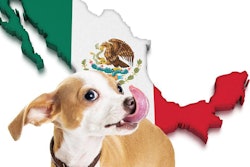
Pets are full-fledged family members whose “parents” want to keep them healthy and safe, including with the pet foods they eat – these are well-established factors that even a global pandemic and resulting economic meltdown can’t change.
Yet it would be naïve and foolhardy to think that the pet food market, and the consumer trends influencing it, won’t be (or haven’t already been) affected by this year’s momentous events. We’re far enough into these crises to see some trends emerging, broadening or deepening. Let’s pull out the crystal ball and see what might have the most impact on pet food.
Health and wellness still key
A new report from Kerry, an ingredients supplier for both pet food and human food, includes data showing how much pet owners value the potential health benefits of pet foods and ingredients. For example, 72% of U.S. dog owners and 67% of cat owners responding to a survey agreed that high-quality pet foods are effective in preventive health care, and 75% of both dog and cat owners agreed that pets with specific health issues can benefit from pet food formulations targeting those conditions.
(Note that the report’s references include studies and surveys from both Mintel and Kerry itself, administered in different years including 2020; it’s unclear whether any of the 2020 surveys were conducted after the pandemic hit.)
As for specific health concerns among pet owners, the ones they say their pets struggle with do not completely match up with the most popular pet food claims: Concerns cited in a 2019 survey include anxiety, obesity, mobility, fur loss, poor vision, lack of appetite/enjoyment of food, lack of playfulness, poor hearing and mental acuity, in that order; all have an incident rate below 20%.
A chart illustrating the appearance of functional health claims on dog and cat foods since July 2016 includes the immune system, probiotics/prebiotics, joints/bones/muscles, eyesight, heart and cardio system, brain and nervous system. Again, the incidence rate of these claims is about 20% or lower, though some, such as the immune system, spiked from July 2018 to June 2019.
Still, these data show that pet food manufacturers are formulating to and marketing those claims based on pets’ health needs and, to some extent, consumer demand. As human food and health go, so go pet food and health; according to the Kerry report, 77% of U.S. adults claim to be actively trying to improve their health, and 65% seek functionality in the foods and beverages they consume every day. At least anecdotal reports indicate that focus has been rising in the wake of the COVID-19 pandemic.
Pet food categories and claims to watch
Pet food market observers, like the experts at Packaged Facts, have prognosticated for a while now that fresh may be the new wave of superpremium – and the market research firm repeated that belief in its latest report, “U.S. Pet Market Outlook 2020–2021 (June 2020 Update).” One sign the report points to is the flood of venture capitalist funding to fresh pet food companies like the Farmer’s Dog, JustFoodforDogs, Ollie, PetPlate and NomNomNow. Plus, the pioneer in the fresh category, Freshpet, keeps expanding its product lines, distribution and marketing.
Other pet food categories that seem to be gaining more attention include ones featuring ancient grains (in the wake of the Food and Drug Administration’s investigation into canine dilated cardiomyopathy and grain-free pet foods), limited ingredient diets, protein-first foods and ones with superfoods. Along with the fresh focus, all seem to dovetail with a pet owner emphasis on health and wellness – or at least, what some believe is healthiest for their pets.
This extends to how the pet foods they buy are sourced and made. Ingredient sourcing still seems to be important to many pet owners: For U.S. owners, “made in the USA” remains a popular claim and feature that may even be increasing, along with a demand for ethical claims, sustainability concerns and cause marketing. Animal welfare stands out among those concerns. In a survey of U.S. dog and cat owners conducted by Packaged Facts in February/March 2020, 69% said they’re concerned about the treatment of animals raised for use in pet food, treats and chews.
Not surprisingly, this percentage outstrips that for animal welfare concerns related to human food, which is fairly significant itself: Innova Market Research data shows 51% of U.S. consumers say they’re very aware of animal cruelty issues, and 53% say they’re willing to pay more for products that support animal welfare, according to an article by Benjamin Ferrer on FoodIngredientsFirst.com.
Changes in where and how pet food is purchased
Of course, we can’t look at how pet food trends are changing without addressing e-commerce, which has been rising for years now – a rise that the pandemic has only hastened, as consumers have stayed home to stay safe. For pet food and pet care, Packaged Facts now expects the e-commerce channel to grab 27% of the U.S. market by the end of this year and reach a 35% share by 2024. Both exceed the market research firm’s pre-pandemic projection of 24% – which was for 2024.
That’s how fast and furious online purchasing is accelerating. “For any marketer or retailer not yet invested to the utmost in e-commerce, now is the time to explore every avenue, including online ordering for home delivery, ‘click-and-collect’ (buy online, pick up in store —or, in the age of coronavirus, curbside) and subscription-based sales,” Packaged Facts’ June report recommends.
For pet food, subscription sales are also growing, spurred by popular e-commerce sites like Chewy.com and Amazon and also a big part of the business model for many of those newer companies offering fresh fare. Some of these companies have reported significant sales increases since the pandemic began.
Besides the appeal of home delivery (especially in these times), another benefit touted by some of the fresh pet food companies is customization. And pet owners at least say they’re willing to pay for that: The Kerry report cites a Mintel “make it mine” trend and data indicating that 61% of U.S. pet owners are willing to pay more for foods customized for their pets’ specific dietary needs. The interest is especially strong among younger pet owners (aged 18-34) and among those buying online: 73%, compared to 68% buying pet food in pet specialty stores and 47% buying in supermarkets.
(Note: Lynn Dornblaser, director of innovation and insight for Mintel, will be among the panelists during Petfood Forum CONNECT, a new virtual event. On September 15, Dornblaser and other experts will offer their insights and analysis on “Pet food trends post-COVID-19: what’s the new normal?”)
Financial concerns may boost private label
Again, it’s unclear when the surveys in the Kerry report were conducted; and to that end, many of the trends, interests and claims covered here could be put on hold by financial concerns among consumers. “Significant job losses related to the pandemic will leave many consumers in financial difficulty, and as a result, they may be unable to shop ethically,” said Innova Market Research, quoted in Ferrer’s article on FoodIngredientsFirst.com about ethical claims.
Similarly, a June 2020 study by McKinsey & Co. showed that more than 50% of Americans surveyed believe it will take longer than six months for the economy to recover; accordingly, they’re adjusting how and where they spend, including being more conservative in their purchasing.
While rising pet adoptions are driving corresponding sales of pet food and other pet products, all of that seems to be happening, at least in the U.S., among higher-income households, which may be better able to withstand some loss of income. Pet ownership is down in lower-income households, according to Packaged Facts, which says these pet owners have been “largely left behind by the premiumization trend.” That could increase as more people experience financial hardship.
The Packaged Facts experts recommend that pet food and product manufacturers focus on “quality but affordable pet care products,” including private label. They believe it’s inevitable that some owners will shift to private label products, including pet food, and say recent sales data confirm that belief.
“Although pet product shoppers demonstrate a high degree of brand loyalty, especially on the pet food side of the aisle, pet product consumers are not indifferent to store brands’ advantages,” the June Packaged Facts report says, citing data after the Great Recession as evidence of the lower cost advantage. In mass market outlets in 2009, sales of private label products increased 14%, as tracked by IRI; and Simmons consumer survey data indicated a 10.1% rise in dry dog food purchases through 2012.
Though it fell back to 7.4% in 2013, private label pet food sales in the U.S. have been on the rise since, according to data from Nielsen. In fact, they reached US$2.2 billion 2019, an increase of 19% in pet retail in the previous year and 75% since 2017. And private label pet food sales have always been strong in other regions globally, especially Western Europe. No doubt that will only grow in the wake of all that’s happening in 2020.
View our continuing coverage of the coronavirus/COVID-19 pandemic.


















